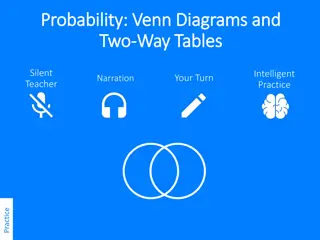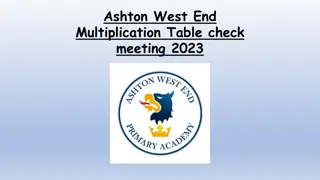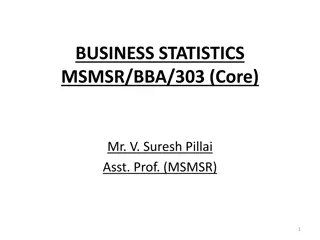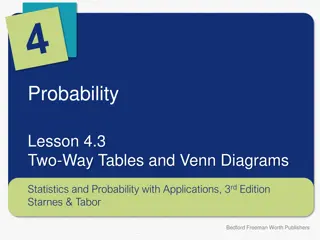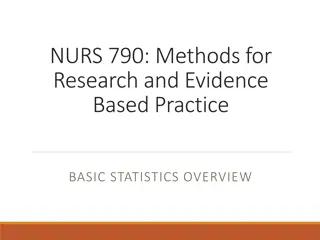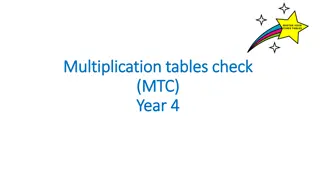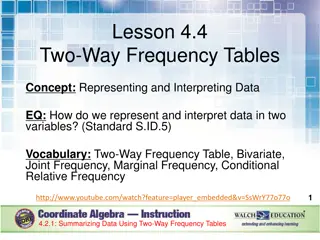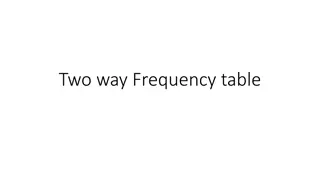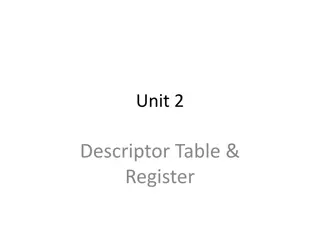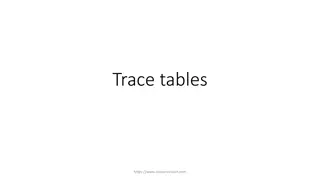Exploring Two-Way Tables in Statistics
Delve into the world of two-way tables in statistics through an interactive introduction, warm-up exercises, and practical examples. Learn how to analyze data, calculate relative frequencies, and draw meaningful conclusions through visual representations. Discover the correlation between different variables and interpret results effectively using the provided resources.
Download Presentation

Please find below an Image/Link to download the presentation.
The content on the website is provided AS IS for your information and personal use only. It may not be sold, licensed, or shared on other websites without obtaining consent from the author.If you encounter any issues during the download, it is possible that the publisher has removed the file from their server.
You are allowed to download the files provided on this website for personal or commercial use, subject to the condition that they are used lawfully. All files are the property of their respective owners.
The content on the website is provided AS IS for your information and personal use only. It may not be sold, licensed, or shared on other websites without obtaining consent from the author.
E N D
Presentation Transcript
Two-Way Tables Introduction
Opening Watch a video introduction to two-way tables accessed at the following link: https://www.khanacademy.org/math/cc-eighth- grade-math/cc-8th-data/two-way-tables/v/two-way- frequency-tables-and-venn-diagrams
Opening Play a Sport Don t play a musical instrument Don t play a sport, Do play a musical instrument Play a sport and a musical instrument Don t play a sport or a musical instrument Instrument/Sport YES NO Total YES NO Total
Two-Way Tables and Relative Frequencies
Warm-Up The scatter plot below compares the number of hot pretzels sold at a concession stand to the number of beverages sold. 1. Draw a line a best fit. 2. Identify the type of correlation and explain what that means in the context of the problem. 3. Write the equation of the line of best fit.
Opening Ten students in a class were asked two questions. They were asked if they do chores at home or not. They were then asked if they receive an allowance or not. The results are shown below. Allowance No Allowance TOTAL Chores No Chores TOTAL
Opening Relative frequency: How often something happens divided by all outcomes. o Can be calculated by row or columns to determine information. o Must add up to 1.00 or 100% Example: 3 out of 4 students prefer dogs to cats o proportion is o relative frequency is 3 divided by 4 or 0.75 or percent of 75%
Opening Look back at the two-way table in Example 3. Can you conclude that students who get an allowance are more likely to do chores than students who do not? Find the relative frequency and see. Allowance No Allowance TOTAL Chores 4 2 6 No Chores 1 3 4 TOTAL 5 5 10 Allowance No Allowance TOTAL Chores No Chores TOTAL
Two-Way Tables/Unit 6 Review
Warm-Up Create a two-way table and a relative frequency table by rows for the following information: The director had 205 dancers with mixed skills. 72 dancers were trained in both folk and classical dance. 43 trained in classical dance, but not folk. 62 dancers were not trained in either discipline.
Warm-Up/Opening The director had 205 dancers with mixed skills. 72 dancers were trained in both folk and classical dance. 43 trained in classical dance, but not folk. 62 dancers were not trained in either discipline. YES FOLK NO FOLK TOTAL YES CLASSICAL NO CLASSICAL TOTAL
YES FOLK NO FOLK TOTAL YES CLASSICAL 72 43 115 NO CLASSICAL 28 62 90 TOTAL 100 105 205 YES FOLK NO FOLK TOTAL YES CLASSICAL NO CLASSICAL TOTAL






